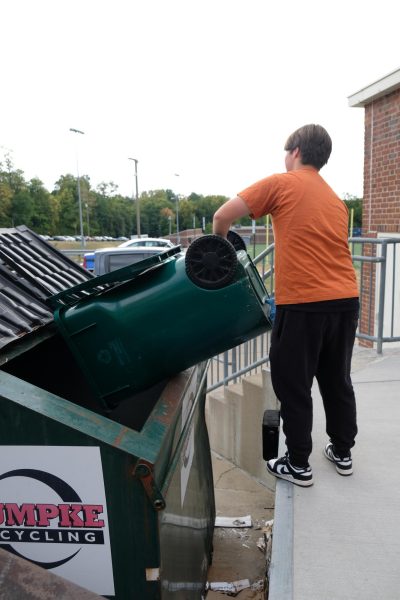A stormy start to the school year
Dripping ceilings and slippery floors pose dangerous obstacles for WHHS students
Alma Russell, ‘20, gazes down at a soaked desk in the journalism lab. On top of the already hectic first week of school, another element of discomfort was added to student’s first few days with the realization that HVAC units throughout the school had begun to drip.
It was fifth bell, and Lauren Posta’s AP English Language and Composition class was assigned an in-class essay. Then, a particular hum started to sound from the ceiling, a sound that teachers in the North Wing of the school are all too familiar with.
“It would start off as sort of a squeak, with a development into a moan…then moving into a high pitch squeal of several different octaves, before coming back to a moaning start,” Posta said.
The noise would frequently disrupt classes, especially in her classes teaching eighth graders, Posta said.
Dubbed “Moaning Myrtle” by the English teachers in the wing, the Heating, Ventilation and Air Conditioning (HVAC) system has garnered a notorious reputation, as it would frequently be the cause of classroom disruptions. Aside from the noises, reports of water leaking from classroom ceilings were frequent during the first few weeks of school. “It did [disturb class], my teacher would have to put tissues down during class to keep it from getting the floor wet,” Darren Thomas-Dixon, ‘20, said.
Since then, the leaking from classroom ceilings has stopped, but the HVAC system continues to be the cause of problems. The noise is still heard in classes throughout the school, and major incidents last year highlight issues with the HVAC.
Last spring, the entire Arts and Sciences Wing was evacuated for a day because of what was described as flooding in multiple classrooms. The first floor classroom of art teacher Donald Stocker was flooded that day. “When I walked in the class that morning, it was coming straight down the center of the room from the ceiling … it was Niagara falls,” Stocker said. “It took most of the day to clean up the mess, because there were definitely chemicals in the water,” Stocker said. During the clean up that day, Stocker and other teachers in the Arts and Science Building had to relocate to the senior high gym, as maintenance staff cleaned up the coolant-laden water.
The new HVAC system was part of a series of renovations to the school involving the construction of new buildings and remodeling of current ones. This project totaled to $67 million and was done over a period of about 3 years. It was one of the largest projects in the Cincinnati Public Schools district, according to a November 2010 issue of The Chatterbox. In fact, in 2015, WHHS received the Gold Cincinnati Design Award for interior renovation, given for “Design conceived and executed at the highest levels of professions,” according to the Cincinnati Design Awards website. Because many students and faculty saw the renovation as necessary, what was considered a drab and poorly-lit campus was transformed in a way that satisfied many in the WHHS community.
WHHS’s HVAC system started experiencing these issues within a few years of being installed, but according to Aqualityhvac.org, the average commercial HVAC system should last 20 to 25 years. It has to do with the type of system the school uses, the chilled beam system. “You see, the chill bean HVAC system is not optimal for the Midwest. It’s much better for drier climates, like Arizona, where it is drier,” plant operator Edwin Sam said.
A chilled beam HVAC system is one which involves a horizontal beam of chilled water in the ceiling that chills the air around it, causing it to sink, replacing it with warm air. This causes convection, thus the cooling room. “Now when it comes to the leaking, you have the chilled water valve and the air is humid; common sense tells you what’s next,” Sam said.
Sam continued to discuss how the Arts and Sciences Wing is governed by an entirely different HVAC system altogether, Variable Air Volume (VAV) boxes, where air is taken from outside and supplied to each room through boxes that are either heated or cooled as needed.
Sam explained that he doesn’t know why both wings have different HVAC systems, nor why the chilled beam system is used in the North Wing. “I came into this, I was not aware of these things until after I was hired, so the people who came before me decided that this was what they were gonna do,” Sam said.
These issues brought up by students and faculty are part of multiple problems that are affecting life at WHHS, which are not only limited to the HVAC, but also include peeling paint on walls, strange smells in the hallways and what some thought to be urine in the ceiling in the spring of last school year.
These renovations led to a big change in WHHS. Overall, students seem to view most of them as beneficial, but many believe there are problems that have not been fixed.
Your donation will support the student journalists of Walnut Hills High School. Your contribution will allow us to purchase equipment, cover our annual website hosting, printing costs and offset competition and conferences fees for students.









